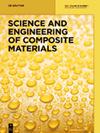连续纤维增强热塑性塑料/金属复合连接中的纤维取向
IF 1.6
4区 材料科学
Q3 Materials Science
引用次数: 0
摘要
摘要连续纤维增强热塑性塑料(CFRT)可以与高强度金属相结合,提供单材料零件无法实现的特性。一个可能的例子是,由于CFRT部件,金属部件中的局部耐高温性与优异的重量相关机械性能相结合。这种方法需要可靠耐用的连接技术,该技术考虑了材料的特定性能,并允许充分利用CFRT/金属混合零件的潜力。在CFRT/金属连接领域,一种很有前途的方法是使用金属销,金属销可以嵌入局部加热的CFRT部件中,以形成形状配合的接头。在现有技术中,主要研究和表征了单个引脚:特别是直接引脚压制过程中的不同纤维取向仅针对单个引脚接头进行了描述。在这一背景下,本研究旨在了解多引脚阵列的光纤定向机制。因此,在本研究范围内,单向增强玻璃纤维/聚丙烯样品通过直接引脚压制和红外加热与具有不同引脚直径、间距和引脚分布的不同1D和2D多引脚阵列连接。因此,使用微型计算机断层扫描来分析由此产生的关节形态。基于所进行的研究,提出了纤维位移机构的模型,并首次提出了具有单向补强的纤维友好型多销接头的设计建议。研究表明,尤其是纤维方向上的引脚间距与引脚直径的关系,对于完全重新固结的接头质量至关重要,并表明在纤维方向上偏移引脚有利于纤维友好的接头工艺。本文章由计算机程序翻译,如有差异,请以英文原文为准。
Fiber orientation in continuous fiber-reinforced thermoplastics/metal hybrid joining via multi-pin arrays
Abstract Continuous fiber-reinforced thermoplastics (CFRTs) can in combination with high-strength metals offer characteristics that cannot be achieved with mono-material parts. One possible example is the combination of locally high-temperature resistance in the metal component with superior weight-related mechanical properties due to the CFRT component. This approach requires a reliable and durable joining technology, which considers the material-specific properties and allows to exploit the full potential of CFRT/metal hybrid parts. A promising approach in the field of CFRT/metal joining is the use of metallic pins, which can be embedded in the locally heated CFRT component to create a form-fitting joint. In the current state of the art, primarily single-pins are investigated and characterized: especially the distinct fiber orientation in the direct pin pressing process is only described for single-pin joints. Behind this background, the present study aims at creating an understanding of the fiber orientation mechanism for multi-pin arrays. Therefore, in the scope of this study, unidirectional reinforced glass fiber/polypropylene samples are joined via direct pin pressing and infrared heating with different 1D and 2D multi-pins arrays with different pin-diameters, spacing and pin distributions. The resulting joint morphology is consequently analyzed using micro-computer-tomography. Based on the performed investigations, a model for the fiber displacement mechanism is proposed, and the first recommendations for the design of fiber-friendly multi-pin joints with unidirectional reinforcements are given. It showed that especially pin-spacing in fiber orientation in dependency of the pin diameter is critical for a fully reconsolidated joint quality, and it is suggested that a pin-offset in the fiber direction is beneficial for a fiber-friendly joining process.
求助全文
通过发布文献求助,成功后即可免费获取论文全文。
去求助
来源期刊

Science and Engineering of Composite Materials
工程技术-材料科学:复合
CiteScore
3.10
自引率
5.30%
发文量
0
审稿时长
4 months
期刊介绍:
Science and Engineering of Composite Materials is a quarterly publication which provides a forum for discussion of all aspects related to the structure and performance under simulated and actual service conditions of composites. The publication covers a variety of subjects, such as macro and micro and nano structure of materials, their mechanics and nanomechanics, the interphase, physical and chemical aging, fatigue, environmental interactions, and process modeling. The interdisciplinary character of the subject as well as the possible development and use of composites for novel and specific applications receives special attention.
 求助内容:
求助内容: 应助结果提醒方式:
应助结果提醒方式:


